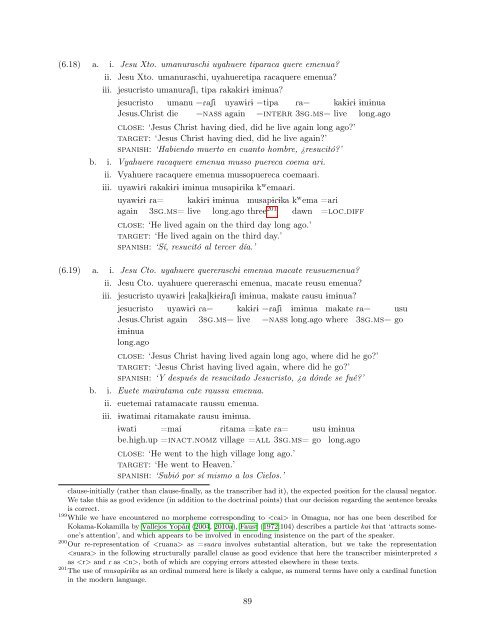draft manuscript - Linguistics - University of California, Berkeley
draft manuscript - Linguistics - University of California, Berkeley
draft manuscript - Linguistics - University of California, Berkeley
You also want an ePaper? Increase the reach of your titles
YUMPU automatically turns print PDFs into web optimized ePapers that Google loves.
(6.18) a. i. Jesu Xto. umanuraschi uyahuere tiparaca quere emenua?<br />
ii. Jesu Xto. umanuraschi, uyahueretipa racaquere emenua?<br />
iii. jesucristo umanuRaSi, tipa Rakak1R1 1m1nua?<br />
jesucristo umanu =RaSi uyaw1R1 =tipa Ra= kak1R1 1m1nua<br />
Jesus.Christ die =nass again =interr 3sg.ms= live long.ago<br />
close: ‘Jesus Christ having died, did he live again long ago?’<br />
target: ‘Jesus Christ having died, did he live again?’<br />
spanish: ‘Habiendo muerto en cuanto hombre, ¿resucitó?’<br />
b. i. Vyahuere racaquere emenua musso puereca coema ari.<br />
ii. Vyahuere racaquere emenua mussopuereca coemaari.<br />
iii. uyaw1R1 Rakak1R1 1m1nua musap1R1ka k w emaaRi.<br />
uyaw1R1<br />
again<br />
Ra= kak1R1 1m1nua musap1R1ka k w ema =aRi<br />
3sg.ms= live long.ago three 201 dawn =loc.diff<br />
close: ‘He lived again on the third day long ago.’<br />
target: ‘He lived again on the third day.’<br />
spanish: ‘Sí, resucitó al tercer día.’<br />
(6.19) a. i. Jesu Cto. uyahuere quereraschi emenua macate reusuemenua?<br />
ii. Jesu Cto. uyahuere quereraschi emenua, macate reusu emenua?<br />
iii. jesucristo uyaw1R1 [Raka]k1R1RaSi 1m1nua, makate Rausu 1m1nua?<br />
jesucristo<br />
Jesus.Christ<br />
1m1nua<br />
long.ago<br />
uyaw1R1<br />
again<br />
Ra= kak1R1 =RaSi 1m1nua makate Ra= usu<br />
3sg.ms= live =nass long.ago where 3sg.ms= go<br />
close: ‘Jesus Christ having lived again long ago, where did he go?’<br />
target: ‘Jesus Christ having lived again, where did he go?’<br />
spanish: ‘Y después de resucitado Jesucristo, ¿a dónde se fué?’<br />
b. i. Euete mairatama cate raussu emenua.<br />
ii. euetemai ratamacate raussu emenua.<br />
iii. 1watimai Ritamakate Rausu 1m1nua.<br />
1wati =mai Ritama =kate Ra= usu 1m1nua<br />
be.high.up =inact.nomz village =all 3sg.ms= go long.ago<br />
close: ‘He went to the high village long ago.’<br />
target: ‘He went to Heaven.’<br />
spanish: ‘Subió por sí mismo a los Cielos.’<br />
clause-initially (rather than clause-finally, as the transcriber had it), the expected position for the clausal negator.<br />
We take this as good evidence (in addition to the doctrinal points) that our decision regarding the sentence breaks<br />
is correct.<br />
199 While we have encountered no morpheme corresponding to in Omagua, nor has one been described for<br />
Kokama-Kokamilla by Vallejos Yopán (2004, 2010a), Faust (1972:104) describes a particle kai that ‘attracts someone’s<br />
attention’, and which appears to be involved in encoding insistence on the part <strong>of</strong> the speaker.<br />
200 Our re-representation <strong>of</strong> as =suaRa involves substantial alteration, but we take the representation<br />
in the following structurally parallel clause as good evidence that here the transcriber misinterpreted s<br />
as and R as , both <strong>of</strong> which are copying errors attested elsewhere in these texts.<br />
201 The use <strong>of</strong> musap1R1ka as an ordinal numeral here is likely a calque, as numeral terms have only a cardinal function<br />
in the modern language.<br />
89
















